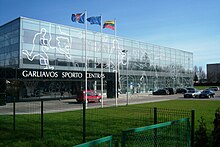
Adam Bernard Mickiewicz was a Polish poet, dramatist, essayist, publicist, translator and political activist. He is regarded as national poet in Poland, Lithuania and Belarus. He also largely influenced Ukrainian literature. A principal figure in Polish Romanticism, he is one of Poland's "Three Bards" and is widely regarded as Poland's greatest poet. He is also considered one of the greatest Slavic and European poets and has been dubbed a "Slavic bard". A leading Romantic dramatist, he has been compared in Poland and Europe to Byron and Goethe.
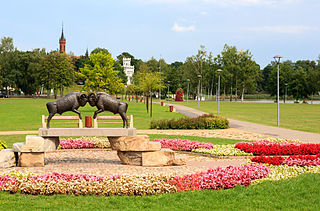
Druskininkai is a spa city on the Nemunas River in southern Lithuania, close to the borders of Belarus and Poland. The city of Druskininkai is known for being a spa resort since the 19th century.

The Republic of Central Lithuania, commonly known as the Central Lithuania, and the Middle Lithuania, was an unrecognized short-lived puppet state of Poland, that existed from 1920 to 1922. It was founded on 12 October 1920, after successful Żeligowski's Mutiny, during which the volunteer 1st Lithuanian–Belarusian Division under command of general Lucjan Żeligowski seized the Vilnius Region that Lithuania made claims to. It was incorporated into Poland on 18 April 1922.

Mińsk Mazowiecki is a town in eastern Poland with 40,999 inhabitants (2020). It is situated in the Masovian Voivodeship and is a part of the Warsaw metropolitan area. It is the capital of Mińsk County. Located 20 kilometers from the city limits of Warsaw and 38 kilometers from Warsaw's center.
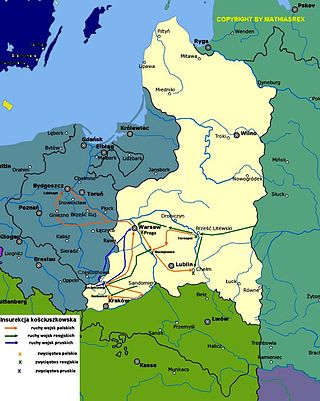
The Kościuszko Uprising, also known as the Polish Uprising of 1794, Second Polish War, Polish Campaign of 1794, and the Polish Revolution of 1794, was an uprising against the Russian and Prussian influence on the Polish–Lithuanian Commonwealth, led by Tadeusz Kościuszko in Poland-Lithuania and the Prussian partition in 1794. It was a failed attempt to liberate the Polish–Lithuanian Commonwealth from external influence after the Second Partition of Poland (1793) and the creation of the Targowica Confederation.

Prince Józef Antoni Poniatowski was a Polish general, minister of war and army chief, who became a Marshal of the French Empire during the Napoleonic Wars.

Józef Oleksy was a Polish left-wing politician who served as Prime Minister of Poland from 7 March 1995 to 7 February 1996, when he resigned due to espionage allegations. He was chairman of the Democratic Left Alliance.

Sejny is a town in north-eastern Poland and the capital of Sejny County, in Podlaskie Voivodeship, close to the northern border with Lithuania and Belarus. It is located in the eastern part of the Suwałki Lake Area, on the Marycha river, being a tributary of the Czarna Hańcza. As of 1999 it had almost 6,500 permanent inhabitants, with a strong seasonal increase during the tourist season.
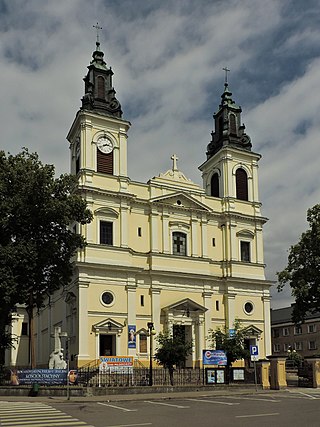
Garwolin is a town on the Wilga river in eastern Poland, capital of Garwolin County, situated in the southeast part of the Garwolin plateau in Masovian Voivodeship, 62 km southeast of Warsaw, 100 km northwest of Lublin. As of December 2021, the town has 17,566 inhabitants.

Lida is a city in Grodno Region, western Belarus, located 168 kilometres (104 mi) west of Minsk. It serves as the administrative center of Lida District. As of 2024, it has a population of 103,916.

The Polish–Lithuanian War was an undeclared war fought in the aftermath of World War I between newly independent Lithuania and Poland, with fighting mainly in the Vilnius and Suwałki regions, which was part of the Lithuanian Wars of Independence and lasted from May 1919 to 29 November 1920. Since the spring of 1920, the conflict happened alongside the wider Polish–Soviet War and was affected by its progress. It was subject to unsuccesful international mediation at the Conference of Ambassadors and the League of Nations.
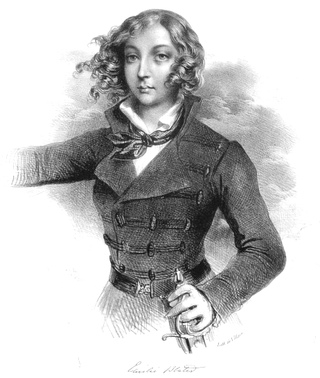
Countess Emilia Broel-Plater was a Polish–Lithuanian noblewoman and revolutionary from the lands of the partitioned Polish–Lithuanian Commonwealth. Raised in a patriotic tradition in Līksna near Daugavpils, she fought in the November Uprising of 1830–1831 against the Russian Empire. She raised a small unit, participated in several engagements in present-day Lithuania, and received the rank of captain in the Polish insurgent forces. When the main forces under the General Dezydery Chłapowski decided to cease fighting and cross into Prussia, Plater vowed to continue the fight and wanted to cross into Poland where the uprising was still ongoing. However, she fell ill and died.

Stanisław Moniuszko was a Polish composer, conductor, organist and pedagogue. He wrote many popular art songs and operas, including The Haunted Manor and Halka, and his music is filled with patriotic folk themes of the peoples of the former Polish–Lithuanian Commonwealth. He is generally referred to as "the father of Polish national opera". Since the 1990s Stanisław Moniuszko has been recognized in Belarus as an important figure to Belarusian culture as well.

Michał Elwiro Andriolli was a Polish illustrator, painter and architect of Italian descent. He is notable for his illustrations to Mickiewicz's Pan Tadeusz, as well as a distinctive style of villas built outside Warsaw. He was probably most well known for his architecture – Świdermajer. This was a regional architectural style common in the Otwock, Poland region. These structures were wooden in construction and were popularized from the turn of the 19th and 20th centuries. Its creator was Michał Elwiro Andriolli. It is characterized by gazebos and decorations above the windows, some of the houses also had turrets. Pine trees were planted together with the buildings as part of the composition.

The Aleksotas Eldership is an eldership in the southern section of the city of Kaunas, Lithuania, bordering the left bank of the Nemunas River. Its population in 2006 was 21,694. The elderate borders Vilijampolė and Centras in the north, Šančiai and Panemunė in the east, Garliava in the south as well as Akademija in the west.

Michał Pius Römer was a Polish-Lithuanian lawyer, scientist and politician.
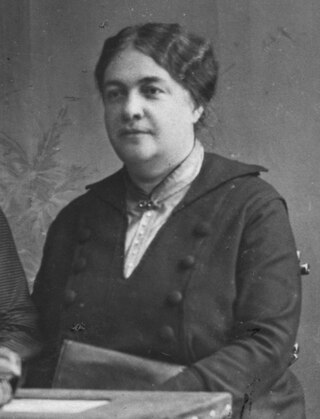
Joanna Narutowicz née Billewicz was a Polish-Lithuanian educational activist and the last owner of the Brėvikiai Manor (Lithuania). Born to the Billewicz family, she was a cousin to Poland's first chief of state Józef Piłsudski and General Leon Billewicz. She married Stanisław Narutowicz, a signatory of the Act of Independence of Lithuania, with whom she ran several cultural facilities. Notably, she headed the gymnasium for girls in Telšiai. She was also the chairperson of the last Polish gymnasium in Kaunas, Lithuania. She left Lithuanian SSR after World War II and settled in Warsaw. She died there and was buried at Powązki Cemetery.

Veiveriai is a town in Lithuania. According to the 2011 census, its population was 1,167. It is located about 18 kilometres (11 mi) southwest of Kaunas on the road to Marijampolė.

Romuald Giedroyć was a Polish-Lithuanian prince from the Lithuanian princely Giedraičiai family, who fought in the Bar Confederation, War of 1792 and the Uprising of 1794 as part of the Grand Ducal Lithuanian Army. From mid-1812 to early 1813, Giedroyć was also the commander of the Lithuanian regiments raised during the French invasion of Russia. In early 1813, he was captured by the Russians and exiled to Arkhangelsk. In 1815, Alexander I of Russia amnestied Giedroyć and made him a Lieutenant general of the Army of Congress Poland.

Aleksander Meysztowicz, also known as Aleksander Eduardowicz Meysztowicz, was a Polish politician and landowner. He was the Minister of Justice of Poland from 1926 to 1928, the chairperson of the Provisional Governing Commission of Central Lithuania from 1921 to 1922, and a member of the State Council of the Russian Empire from 1909 to 1917.



![Park near the Maisys [lt] stream Garliava 2021a.jpg](http://upload.wikimedia.org/wikipedia/commons/thumb/d/d2/Garliava_2021a.jpg/220px-Garliava_2021a.jpg)

